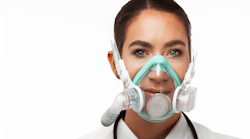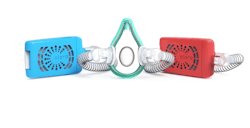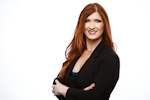We’ve all been doing it—adjusting to wearing more personal protective equipment (PPE) than ever before. This includes wearing N95 and/or KN95 masks.1 Many medical and dental professionals have reported adverse side effects—including fatigue, irritability, high pulse rate, memory loss and/or forgetfulness, headaches, depression, and dermatological problems—as a result of prolonged use of these types of masks.2 These side effects, along with many others, may be caused by increased inhalation of CO2 levels.3 In addition, some practitioners have difficulties wearing their loupes with the masks.
Clinicians are also wearing face shields.4 Face shields are important for protecting the front and sides of the face from spatter and sprays. However, the use of masks5 and face shields can hinder communication, especially if a coworker or patient has difficulty hearing.
Patient rapport with the dental professional is often based on trust and interpersonal relationships. Some patients may have problems understanding their dental practitioner due to hearing challenges. Some may also find it hard to connect with their dental practitioner due to the inability to see the entire face and facial expressions. This may be particularly challenging when presenting care to new patients, anxious patients, or those who require extensive treatment.
These challenges are all common and one might think, “There has to be a better way to practice.”
Enter Clara. Clara is a new respirator mask that offers many positive features:
- You breathe in clean air, and expired air is additionally filtered. Clara has two air filters: when you inhale, there is minimal resistance to the air that is inspired, and it is filtered through a high-efficiency particulate air (HEPA) filter. During expiration, air is filtered through a second HEPA filter before it enters the environment. There are backflow valves so that only inspired air will enter the mask and only expired air will leave it.
- Two models are available: single filter and dual filter. A single filter can be used to filter only inspired air, whereas a dual filter can filter both inspired and expired air.
- The mask is clear. Patients can see most of the clinician’s face behind the mask. They can see facial expressions and will have an easier time communicating with the dental practitioner.
- Patients can hear you speak. There is an oval-shaped area on the front of the mask that transmits sound with minimal interference and without compromising air filtration.
- The mask seals the clinician’s face with a soft silicone gasket. No more dents in your face from wearing tight N95 masks!
- There’s room for your loupes. The mask is designed to be worn lower on the nose than traditional N95 masks. This respirator provides chin coverage, so the mask stays in place. The nose area of the mask is tapered to provide space for most commercially available loupes.
- This respirator mask is sustainable as a stand-alone mask. It eliminates the need for N95 or KN95 respirator masks and traditional disposable masks. The Clara mask can be disinfected between patients and disassembled at the end of the day for cleaning.
- The Clara mask is customizable. There are multiple sizes of masks available, and the fit can be customized for various facial shapes.
COVID-19 has changed our traditional methods of practice indefinitely. Dental practitioners must find a practical, comfortable, and safe way to practice. Clara seems to check all of the boxes that we need to be able to practice comfortably and communicate effectively with our patients and team. It’s worth having a look. Clara just became available for purchase today! Check out breatheclara.com for more information.
References
- Guidance for dental settings. Interim infection prevention and control guidance for dental settings during the coronavirus disease 2019 (COVID-19) pandemic. National Center for Immunization and Respiratory Diseases (NCIRD), Division of Viral Diseases. Centers for Disease Control and Prevention. Updated August 28, 2020. https://www.cdc.gov/coronavirus/2019-ncov/hcp/dental-settings.html
- Guignon AN. Headaches, exhaustion, anxiety: The physical and emotional challenges of returning to work during the pandemic. DentistryIQ. June 11, 2020. https://www.dentistryiq.com/covid-19/article/14177630/headaches-exhaustion-anxiety-the-physical-and-emotional-challenges-of-returning-to-work-during-the-pandemic
- Sinkule, EJ, Powell, JB, Goss, FL. Evaluation of N95 respirator use with a surgical mask cover: effects on breathing resistance and inhaled carbon dioxide. Ann Occup Hyg. 2013;57(3):384-398. doi:10.1093/annhyg/mes068
- Interim infection prevention and control recommendations for healthcare personnel during the coronavirus disease 2019 (COVID-19) pandemic. National Center for Immunization and Respiratory Diseases (NCIRD), Division of Viral Diseases. Centers for Disease Control and Prevention. Updated July 15, 2020. https://www.cdc.gov/coronavirus/2019-ncov/hcp/infection-control-recommendations.html
- Marrone N. Masks and distancing make it tough for the hard-of-hearing, but here’s how to help. The Conversation. May 1, 2020. https://medicalxpress.com/news/2020-05-masks-distancing-tough-hard-of-hearing.html
Editor’s note: This article first appeared in Through the Loupes newsletter, a publication of the Endeavor Business Media Dental Group. Read more articles at this link and subscribe here.
Pamela Maragliano-Muniz, DMD, is the chief editor of DentistryIQ and editorial co-director of Through the Loupes. Based in Salem, Massachusetts, Dr. Maragliano-Muniz began her clinical career as a dental hygienist. She went on to attend Tufts University School of Dental Medicine, where she earned her doctorate in dental medicine. She then attended the University of California, Los Angeles, School of Dental Medicine, where she became board-certified in prosthodontics. Dr. Maragliano-Muniz owns a private practice, Salem Dental Arts, and lectures on a variety of clinical topics. You may contact her at [email protected].









